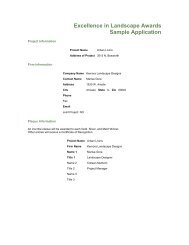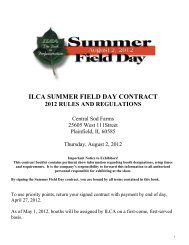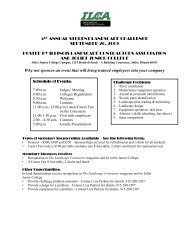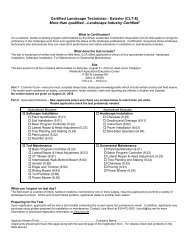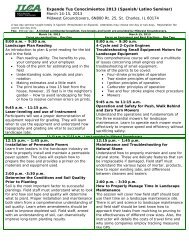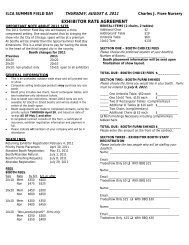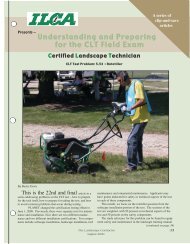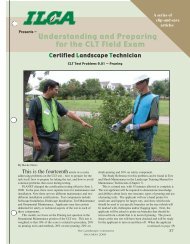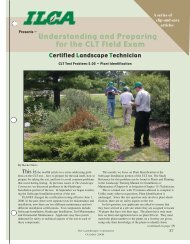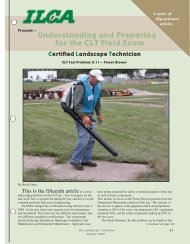8.85 Aerator - Illinois Landscape Contractors Association
8.85 Aerator - Illinois Landscape Contractors Association
8.85 Aerator - Illinois Landscape Contractors Association
- No tags were found...
Create successful ePaper yourself
Turn your PDF publications into a flip-book with our unique Google optimized e-Paper software.
C L T F i e l d E x a m P r e p<br />
(continued from page 33)<br />
Equipment Operation and Safety in the<br />
<strong>Landscape</strong> Training Manual for<br />
Maintenance Technicians (Chapter 8).<br />
This is a timed test, with 15 minutes<br />
allowed to complete it.<br />
The test assumes you have been sent<br />
to aerate a lawn. The customer shows<br />
an interest in the<br />
machine, so the test<br />
applicant should take<br />
time to explain how<br />
to check and prepare<br />
the machine for operation.<br />
Prepare the<br />
site, making sure to<br />
remove debris, and<br />
start aerating the<br />
area. Remember to<br />
use caution when<br />
crossing the sidewalk.<br />
Professor<br />
Armando Actis is a<br />
product trainer and<br />
safety instructor. He<br />
has been a CLT judge<br />
since moving to<br />
<strong>Illinois</strong> from New<br />
Jersey in 2002. In<br />
that time, he has<br />
judged a number of<br />
small equipment categories,<br />
including<br />
Power Blower, String<br />
Trimmer, 21-inch<br />
Mower, Edger and<br />
Line Trimmer, Chain<br />
Saw, Tiller, <strong>Aerator</strong><br />
and Concrete Saw in<br />
addition to several mower categories.<br />
As always, safety gear will be on<br />
one of the front tables, in the same area<br />
where applicants read over the test<br />
question. Collecting and actually using<br />
the safety gear should be automatic,<br />
since failure to do so can disqualify<br />
applicants from almost any test. For<br />
this test, ear and eye protection are<br />
required, as are a hat and gloves, long<br />
pants and boots – the usual safety gear<br />
for hand-held power tools. The hat or<br />
cap is not a safety requirement for<br />
using the aerator, but it is necessary to<br />
protect from the sun and heat stroke.<br />
Actis walks us through the test:<br />
“The test applicants should check the<br />
aerator like any internal combustion<br />
equipment, check the oil, and check<br />
the tines. The tines stick out in the<br />
back, and the applicants must check<br />
that they’ve been properly installed,<br />
with nothing loose. The lever on the<br />
machine should be up, in transport<br />
mode – with the tines up. When the<br />
lever is down, the tines should make<br />
contact with the ground, so make sure<br />
that the lever is working.<br />
“Prior to this, the judge (posing as<br />
an interested customer) will ask about a<br />
t-handled tool. The test applicants<br />
should take this tool from the table<br />
when they get their safety equipment.<br />
They should use that to take a soil sample<br />
by pushing it into the earth about<br />
ten inches. Show the judge the soil<br />
sample, and point<br />
out how compacted<br />
it is, how much dirt<br />
is in it and how<br />
much dead grass – a<br />
little or a lot.<br />
Explain why aeration<br />
would work, how the<br />
air would get at the<br />
roots, how the lawn<br />
would benefit from<br />
aeration. They don’t<br />
have to make a scientific<br />
or super-technical<br />
explanation,<br />
just say if the soil<br />
would benefit from it<br />
— and then explain<br />
the benefits of aeration.<br />
“The land where<br />
you will be aerating<br />
will be painted off in<br />
a rectangular U-<br />
shape, where you<br />
take a right-hand<br />
turn and then go<br />
back down. Before<br />
you turn on the<br />
machine, walk the<br />
area and remove any<br />
debris such as pop<br />
cans or branches. The judge may put a<br />
sprinkler head in the test area. It will be<br />
visible, and you if see one, you should<br />
flag it, because where there are sprinkler<br />
heads, there are pipes under the<br />
ground. The tines of an aerator go<br />
down three to four inches, so you<br />
should stay clear of this area.<br />
“Once this is done, turn the machine<br />
on full throttle and put the tines down.<br />
34 The <strong>Landscape</strong> Contractor<br />
June 2009




